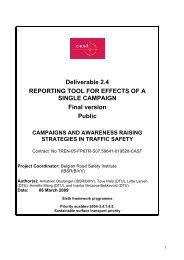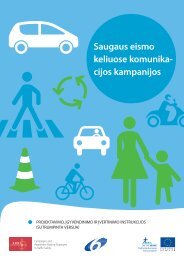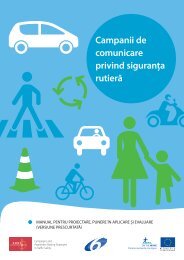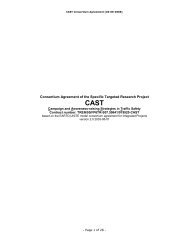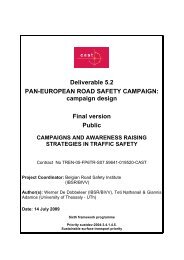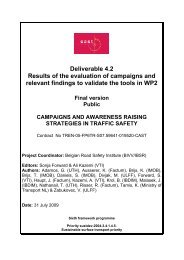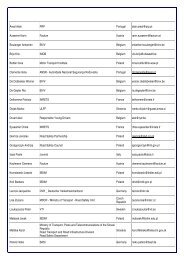Deliverable D 1.3 RESULTS OF META-ANALYSIS ... - cast-eu.org
Deliverable D 1.3 RESULTS OF META-ANALYSIS ... - cast-eu.org
Deliverable D 1.3 RESULTS OF META-ANALYSIS ... - cast-eu.org
You also want an ePaper? Increase the reach of your titles
YUMPU automatically turns print PDFs into web optimized ePapers that Google loves.
Campaigns and awareness raising strategies in traffic safety — <strong>Deliverable</strong> D <strong>1.3</strong>Addressing social norms, emotional-rational content, and clear identificationof target group could also be importantSubgroup analyses in this report give insight into some factors that we were unableto enter into meta-regression analysis, due to the lack of descriptive data available inthe evaluation studies. As we have said, those campaigns in our sample that identifytarget groups, address the social norm, or combine emotional and rationalinformation, are associated with better accident and seatbelt use outcomes. The useof a reward, or a pledge system in which people ‘pledge’ to change behaviour, arealso associated with better seatbelt use outcomes, as is consultation with a sampleof the target for the development of campaign content. Although it should beremembered that these associations were found when other factors are notcontrolled for, they remain potentially important. Just because they could not beincluded as candidate models for meta-regression analysis does not mean they arenot meaningful influences on campaign effect.Consider limitations of meta-analysis when interpreting resultsA further reason for including subgroup analyses in this report is as a complement tothe meta-regression data, which is generated on the basis of several importantassumptions. We have attempted to delineate theoretical and methodologicallimitations throughout this report and while it is not our aim to repeat them here,willingness to accept the conclusions we draw should depend on the level ofagreement with decisions we have made and assumptions we have taken duringtreatment of the data.In this vein, it is worth outlining the breadth of the database of road safety campaignevaluations itself. It contains 433 effects, including 133 seatbelt use effects and 115accident effects. Most of the studies are drawn from scientific journals and institutereports, and they summarize campaigns carried out across the last 30 years, mainlyin Europe and USA. The most common campaign themes in the database areseatbelts (34 per cent of effects for seatbelt campaigns), drink-driving (24 per cent)and speeding (15 per cent). The types of campaign tending to use accidents as ameasure of campaign effect are drink-driving (36 per cent of accident effects are fordrink-drive campaigns) and speeding (22 per cent) campaigns. There is someevidence that different countries tend to focus on certain themes; in particular manyseatbelt-themed campaigns are American (69 per cent) and many drink-drivecampaigns Australian (43 per cent). The campaigns cover a wide range scope andduration, from less than one hundred to over a million people and from 1 day toseveral years. In accepting the conclusions drawn from this data, one must assumethat we can learn from the regularities apparent amongst such disparate information.Evaluation studies should include more informationFinally, we would like to recommend improvements to reduce the number of thoselimitations that have their roots in the original campaign evaluation studies.First, we are unable to say anything about the effects of campaigns on the intensityof safety outcomes such as speed, because such measures were few and farbetween. It would be interesting to evaluate known speeds for a known number of11



